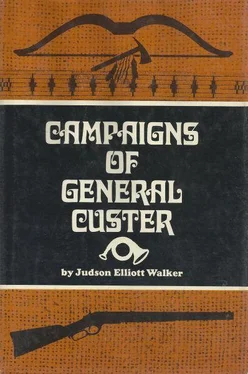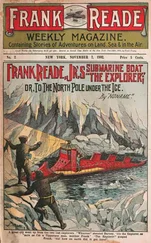Walker Array - Campaigns of General Custer in the North-west, and the final surrender of Sitting Bull
Здесь есть возможность читать онлайн «Walker Array - Campaigns of General Custer in the North-west, and the final surrender of Sitting Bull» весь текст электронной книги совершенно бесплатно (целиком полную версию без сокращений). В некоторых случаях можно слушать аудио, скачать через торрент в формате fb2 и присутствует краткое содержание. Жанр: Историческая проза, Исторические приключения, Приключения про индейцев, на английском языке. Описание произведения, (предисловие) а так же отзывы посетителей доступны на портале библиотеки ЛибКат.
- Название:Campaigns of General Custer in the North-west, and the final surrender of Sitting Bull
- Автор:
- Жанр:
- Год:неизвестен
- ISBN:нет данных
- Рейтинг книги:5 / 5. Голосов: 1
-
Избранное:Добавить в избранное
- Отзывы:
-
Ваша оценка:
- 100
- 1
- 2
- 3
- 4
- 5
Campaigns of General Custer in the North-west, and the final surrender of Sitting Bull: краткое содержание, описание и аннотация
Предлагаем к чтению аннотацию, описание, краткое содержание или предисловие (зависит от того, что написал сам автор книги «Campaigns of General Custer in the North-west, and the final surrender of Sitting Bull»). Если вы не нашли необходимую информацию о книге — напишите в комментариях, мы постараемся отыскать её.
Campaigns of General Custer in the North-west, and the final surrender of Sitting Bull — читать онлайн бесплатно полную книгу (весь текст) целиком
Ниже представлен текст книги, разбитый по страницам. Система сохранения места последней прочитанной страницы, позволяет с удобством читать онлайн бесплатно книгу «Campaigns of General Custer in the North-west, and the final surrender of Sitting Bull», без необходимости каждый раз заново искать на чём Вы остановились. Поставьте закладку, и сможете в любой момент перейти на страницу, на которой закончили чтение.
Интервал:
Закладка:
A brief, fragmentary sketch of the history and personnel of the principal tribes who have been introduced to the Teader in the foregoing pages, may well serve as an appendix to this volume.
The country on the Washita River and in and about the Wichita Mountains, as well as along the Canadian Eiver, is highly fertile and capable of sustaining a large population. The scenery is beautiful and the climate delightful The winters are mild and short; grass is plentiful for the sustenance of stock; timber is abundant; and the surrounding country at Wichita Mountains is well watered and unsurpassed for salubrity.
The Wichitas were once a very numerous and warlike people, inhabiting the Wichita Mountains from time immemorial Remains of their ancient villages and fortifications are yet plainly to be traced in this locality. They claim to have once held dominion over a very large extent of country, from the junction of the Wichita (now Washita), with Red River, and extending westward to a line running due south from the headwaters of the Canadian to Red River. Their principal village was situated near the head of Rush Creek, a tributary of the Wichita, or Washita, where they lived for many years in peace and comparative comfort, raising abundant corn and vegetables, plentifully supplied with buffalo meat, and deriving a profitable income from trade with the Comanches of bows and arrows, for mules, horses and buffalo robes. In 1834 their village was removed to Cache Creek, in the Wichita Mountains, where for many years they remained undisturbed. These mountains are more properly peaks, surrounded by rich valleys, covered with luxuriant grasses and abounding in mineral wealth; buffalo, deer, antelope, bear, turkeys, grouse, quails and small game are plentiful Altogether a country better adapted to supply the physical wants of men and animals could not be found anywhere; and here dwelt for many years these untaught children of nature, at peace with the world and with each other.
In the year 1858 they became involved in difficulties with the Comanches, a wild, roving tribe of the plains, and through fear of them abandoned their pleasant village, never to return, and sought refuge and protection near Fort Ar-buckle, leading an unsettled life, until a few years previous to the breaking out of the war of the rebellion, when they were located near Fort Cobb. At the opening of the civil war they were again compelled to abandon their homes and remove to Kansas, remaining loyal to the government during the four years' conflict. After the close of the war they were returned to Fort Cobb, decimated by disease and hardships, and destitute of everything save the scanty supplies furnished them by the government. Dispirited, and despairing of ever again regaining their beautiful homes in the Wichita Mountains, where the bones of their ancestry had slumbered for ages, or of obtaining compensation for the loss of their lands or reward for their loyalty, they were unwilling to again improve their homes, until assured that they should remain in peaceable possession of them.
Gen. W. B. Hazen, then Colonel of the 6th U. S. Infantry, was. in charge of the wild tribes by appointment of General Sherman, who had great confidence in his ability as an executive and administrative officer, and it may well be said that CoL Hazen justified the confidence of his superior officer by proving himself efficient in every position that he held in the Indian Department. To him the discouraged Wichitas appealed for the justice that was the meed of their industry, thrift, and devotion to the government. To the Cheyennes, Kiowas, Comanches and Apaches, wild tribes of the plains, had been given land, and large sums of money were annually expended upon them.
The Wichitas, of whom Gen. Hazen speaks as a peaceable and deserving band of Indians, had been given no land at all, and were there merely by sufferance, while the beautiful country to whose river and mountain they had given their own name, was in the possession of alien tribes.
Previous to this time the aimless policy of the government toward the wild Indians had begun to assume definite shape, and a marked change for the better became apparent in the management of Indian affairs.
During the summer of 1866, before the Union Pacific Railroad was built, Gen. Hazen was crossing the plains in an ambulance, and while riding along, giving some thought to the unsettled condition of Indian affairs, a plan suggested itself to him which was afterward approved by General Sherman. It was to allot a given amount of land to each tribe and compel them to live upon it; to feed them and build houses for them; to provide school-houses and teachers ; to furnish agricultural implements; to teach them husbandry, and otherwise care for them until they should become self-sustaining. It was at Gen. Hazen 7 s suggestion that the wild tribes were sent south of the Arkansas River to locate on reservations. The Kiowas, Comanches, Chey-ennes and Arrapahoes then resided on the Arkansas and Smokey Rivers, ranging as far north as the Platte.
In a council of the warriors held near Fort Dodge, Kansas, the war chiefs agreed to settle upon a reservation, but declared that they would not go unless they could have some one with whom they were acquainted to go with them to act a3 their agent. General Hazen at once sent for Colonel A. G. Boone, who had had many years of experience among wild tribes. The Indians consented to go if Colonel Boone would go with them. Their agency was then located near the base of the Wichita Mountains, about thirty miles north of the northern boundary line of Texas, and here the Kiowas and Comanches were finally settled, their new camps being called "Medicine Bluffs," and was generally known among the Indians as " Medicine Lodge Creek."
The Cheyennes and Arrapahoes were located south of the Arkansas River, near the North Canadian-a fine location for a reservation, there being plenty of wood, water and grass.
These warriors subsequently proved troublesome; so much so that a military post, called Fort Reno, was established there. The Indians in this section of the country
Lave given the government much trouble, together with the wild Apaches, who mostly roam in New Mexico and Old Mexico.
In the meantime, Generals Sherman and Sheridan were active in their respective duties in trying to bring about a peaceful result that would be satisfactory to the general government and beneficial to the Indians. General Hazen and Colonel Boone were encouraged and supported in every manner possible within the compass of the offices of these two worthy military chiefs. Their presence had a good moral effect upon the Indians. The Indian chiefs well knew their power and influence. They respected them as brave soldiers-a characteristic of war chiefs. They named General Sherman, " the Big-White-Chief," and General Sheridan, " The-Little-Big-Short-Chief-that-Eides-Fast "- in reference to his famous twenty-mile-ride into Winchester, known in history and poetry as " Sheridan's Bide." And they well knew the famous black horse on which he then xode, as he rode the same horse seventy-five miles across the prairie in a single night, in order to catch them napping, before daybreak in the morning. The war-chiefs often made kind inquiries after Sheridan, saying he was a brave soldier and a "heap-good-man." Occasionally one would -call him " Big-Heart-with-a-Fast-Horse."
Sheridan's plan with Indians determined to go on the war-path was invariably, " surround them and thrash them soundly"-but treat them well and kindly while they remain on their reservations and behave themselves.
General Sheridan is acknowledged by Western men to be not merely a good Indian fighter, but a good administration man in military affairs generally in the Western country. His immediate subordinate, General Alfred H. Terry, commanding the Department of Dakota, is deserving of great credit for his management of the wild tribes in the Northwest. He is a man of superior executive ability, and his honor and fidelity cannot be questioned.
Читать дальшеИнтервал:
Закладка:
Похожие книги на «Campaigns of General Custer in the North-west, and the final surrender of Sitting Bull»
Представляем Вашему вниманию похожие книги на «Campaigns of General Custer in the North-west, and the final surrender of Sitting Bull» списком для выбора. Мы отобрали схожую по названию и смыслу литературу в надежде предоставить читателям больше вариантов отыскать новые, интересные, ещё непрочитанные произведения.
Обсуждение, отзывы о книге «Campaigns of General Custer in the North-west, and the final surrender of Sitting Bull» и просто собственные мнения читателей. Оставьте ваши комментарии, напишите, что Вы думаете о произведении, его смысле или главных героях. Укажите что конкретно понравилось, а что нет, и почему Вы так считаете.












